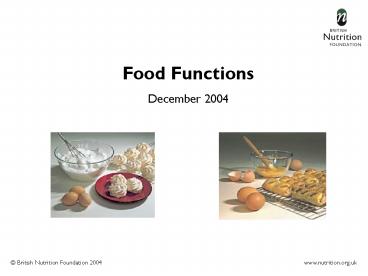Food Functions - PowerPoint PPT Presentation
1 / 17
Title:
Food Functions
Description:
Blend cornflour with a little milk and sugar to a smooth paste, ... colour and sweet flavour of caramel; thicken products, such as sauces and custards. ... – PowerPoint PPT presentation
Number of Views:65
Avg rating:3.0/5.0
Title: Food Functions
1
Food Functions December 2004
2
This presentation looks at the following food
functions
Because of their physical and chemical
properties, foods perform different functions
which can be used in the production of food
products.
3
Set
How do these work?
How do you set? Blend cornflour with a little
milk and sugar to a smooth paste, gradually add
to hot milk, stir and heat to boiling point -
allow to cool.
Why does it set? The corn starch grains swell and
rupture, releasing starch which absorbs the
liquid, the mixture sets on cooling.
4
Glaze
How do these work?
How do you glaze? Brush beaten egg over the
surface of the sausage roll before baking.
Why does it glaze? The surface of the sausage
roll takes on a shiny golden brown appearance due
to coagulation of egg proteins and the Maillard
browning reaction.
5
Thicken
How do these work?
How do you thicken? Blend the flour with melted
fat, gradually add the liquid, stir and heat to
boiling point.
Why does it thicken? Starch granules in the flour
swell, rupture and release starch which absorbs
the liquid causing the mixture to gelatinise.
6
Bulk
How do these work?
How do you bulk? Boil sugar with fruit juice,
reduce mixture to thickness required, add
prepared fruit, assemble pie and bake.
Why does it bulk? Water evaporates and the
mixture caramelises producing a syrup or a thick
puree.
7
Bind
How do these work?
How do you bind? Combine yogurt with main
ingredients and stir.
Why does it bind? Liquid present in yogurt is
absorbed by the starch granules and hydrates
proteins in the flour to form a network.
8
Aerate
How do these work?
How do you aerate? Whisk egg white to produce a
foam. Fold foam with other ingredients to create
light mixture, e.g. sugar.
Why does it aerate? Protein in egg white denature
and trap air in a stable network.
9
Protein and its functional properties in food
products
- Protein is made up of chains of small units
called amino acids. - Proteins perform different functions in food
products depending on their physical shape and
chemical structure. - The structure of protein changes due to heat,
salts, pH and mechanical action. This process is
called denaturation.
10
Protein and its functional properties in food
products
- When proteins unfold from their coiled state and
form a solid network, they coagulate, or set,
e.g. a boiled egg. - The amount and type of protein present in flour
determines its suitability for use in different
products, e.g. bread required strong flour with a
high protein content. - Meringue, cheese, bread and jelly are examples
of food products which use the functional
properties of protein.
11
Fat and its functional properties in food products
- Fats are made up of fatty acids and glycerol.
- Fats are often described as saturated or
unsaturated, depending on the proportion of the
different types of fatty acids they contain. - Fats that are liquid at room temperature are
called oils.
12
Fat and its functional properties in food products
- When fats absorb oxygen they spoil and become
rancid. - Fats have many different functions in food
produce short textures in biscuits and pastry/
melt over a range of temperatures, which allows
margarine to spread straight form the fridge /
allow air to be whisked into a cake mixture. - All fats and oils have a different taste and
smell, e.g. olive oil (suitable for a salad
dressing) and lard (suitable for pastry).
13
Carbohydrate and its functional properties in
food products
- Carbohydrates cover a wide range of natural
compounds, such as starches and sugars, which are
based on monosaccharides. - Carbohydrates are divided into 3 main groups
according to their size - monosaccharides, e.g. glucose
- disaccharides (two monosaccharides), e.g.
maltose - polysaccharides (many monosaccharides), e.g.
starch
14
Carbohydrate and its functional properties in
food products
- Carbohydrates perform different functions in food
products. They help cause the colour change of
bread, toast and bakery products contribute to
the chewiness, colour and sweet flavour of
caramel thicken products, such as sauces and
custards. - Sugars contribute to the flavour of many
products, and can act as preservatives, e.g. jam.
15
Functions of Colloidal Systems in Food Products
- Colloidal systems give structure, texture and
mouthfeel to many products, e.g. jam. - Colloids are formed when one substance is
dispersed through another - gels - a liquid held in a solid network, e.g.
jam or jelly - emulsions - oily and watery liquids mixed
together, e.g. milk and butter / - foams - bubbles of gas trapped in a liquid, e.g.
whisked egg white or whipped cream - solid foam - bubbles of gas trapped in a solid,
e.g. meringue, cake, bread
16
Functions of Colloidal Systems in Food Products
- An emulsion may separate, so an emulsifying agent
may be used to help the oil and water phases to
mix permanently. - If a gel is allowed to stand for a time it may
start to 'weep'. This loss of liquid is know as
syneresis.
17
For further information, go to
www.nutrition.org.uk































